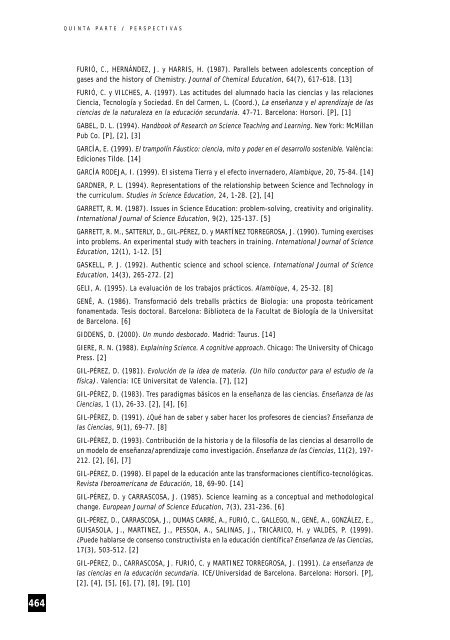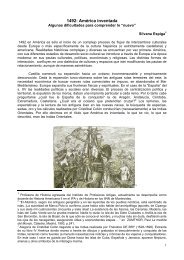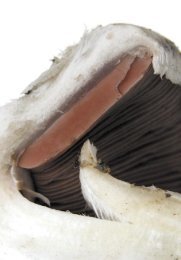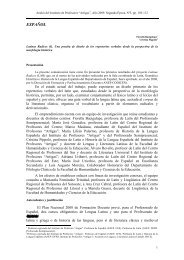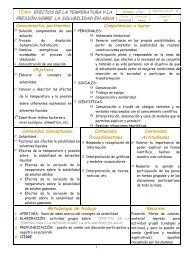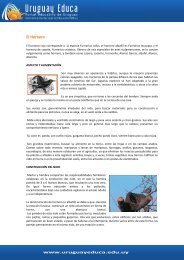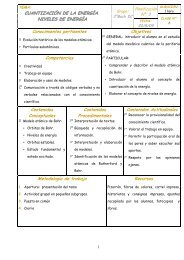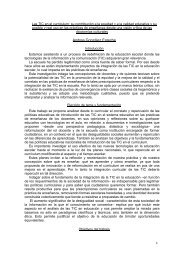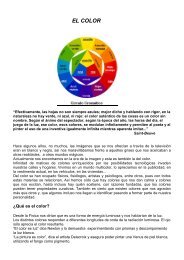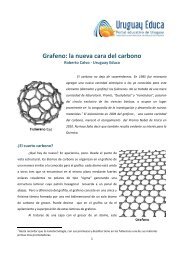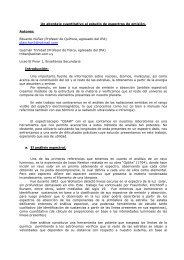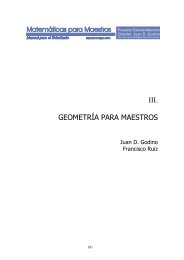QUINTA PARTE / PERSPECTIVASFURIÓ, C., HERNÁNDEZ, J. y HARRIS, H. (1987). Parall<strong>el</strong>s between adolescents conception ofgases and the history of Chemistry. Journal of Chemical <strong>Educa</strong>tion, 64(7), 617-618. [13]FURIÓ, C. y VILCHES, A. (1997). Las actitudes d<strong>el</strong> alumnado hacia <strong>la</strong>s ciencias y <strong>la</strong>s r<strong>el</strong>acionesCiencia, Tecnología y Sociedad. En d<strong>el</strong> Carmen, L. (Coord.), La enseñanza y <strong>el</strong> aprendizaje de <strong>la</strong>sciencias de <strong>la</strong> naturaleza en <strong>la</strong> educación secundaria. 47-71. Barc<strong>el</strong>ona: Horsori. [P], [1]GABEL, D. L. (1994). Handbook of Research on Science Teaching and Learning. New York: McMil<strong>la</strong>nPub Co. [P], [2], [3]GARCÍA, E. (1999). El trampolín Fáustico: ciencia, mito y poder en <strong>el</strong> desarrollo sostenible. València:Ediciones Tilde. [14]GARCÍA RODEJA, I. (1999). El sistema Tierra y <strong>el</strong> efecto invernadero, A<strong>la</strong>mbique, 20, 75-84. [14]GARDNER, P. L. (1994). Representations of the r<strong>el</strong>ationship between Science and Technology inthe curriculum. Studies in Science <strong>Educa</strong>tion, 24, 1-28. [2], [4]GARRETT, R. M. (1987). Issues in Science <strong>Educa</strong>tion: problem-solving, creativity and originality.International Journal of Science <strong>Educa</strong>tion, 9(2), 125-137. [5]GARRETT, R. M., SATTERLY, D., GIL-PÉREZ, D. y MARTÍNEZ TORREGROSA, J. (1990). Turning exercisesinto problems. An experimental study with teachers in training. International Journal of Science<strong>Educa</strong>tion, 12(1), 1-12. [5]GASKELL, P. J. (1992). Authentic science and school science. International Journal of Science<strong>Educa</strong>tion, 14(3), 265-272. [2]GELI, A. (1995). La evaluación de los trabajos prácticos. A<strong>la</strong>mbique, 4, 25-32. [8]GENÉ, A. (1986). Transformació d<strong>el</strong>s treballs pràctics de Biologia: una proposta teòricamentfonamentada. Tesis doctoral. Barc<strong>el</strong>ona: Biblioteca de <strong>la</strong> Facultat de Biología de <strong>la</strong> Universitatde Barc<strong>el</strong>ona. [6]GIDDENS, D. (2000). Un mundo desbocado. Madrid: Taurus. [14]GIERE, R. N. (1988). Exp<strong>la</strong>ining Science. A cognitive approach. Chicago: The University of ChicagoPress. [2]GIL-PÉREZ, D. (1981). Evolución de <strong>la</strong> idea de materia. (Un hilo conductor para <strong>el</strong> estudio de <strong>la</strong>física). Valencia: ICE Universitat de Valencia. [7], [12]GIL-PÉREZ, D. (1983). Tres paradigmas básicos en <strong>la</strong> enseñanza de <strong>la</strong>s ciencias. Enseñanza de <strong>la</strong>sCiencias, 1 (1), 26-33. [2], [4], [6]GIL-PÉREZ, D. (1991). ¿Qué han de saber y saber hacer los profesores de ciencias? Enseñanza d<strong>el</strong>as Ciencias, 9(1), 69-77. [8]GIL-PÉREZ, D. (1993). Contribución de <strong>la</strong> historia y de <strong>la</strong> filosofía de <strong>la</strong>s ciencias al desarrollo deun mod<strong>el</strong>o de enseñanza/aprendizaje como investigación. Enseñanza de <strong>la</strong>s Ciencias, 11(2), 197-212. [2], [6], [7]GIL-PÉREZ, D. (1998). El pap<strong>el</strong> de <strong>la</strong> educación ante <strong>la</strong>s transformaciones científico-tecnológicas.Revista Iberoamericana de <strong>Educa</strong>ción, 18, 69-90. [14]GIL-PÉREZ, D. y CARRASCOSA, J. (1985). Science learning as a conceptual and methodologicalchange. European Journal of Science <strong>Educa</strong>tion, 7(3), 231-236. [6]GIL-PÉREZ, D., CARRASCOSA, J., DUMAS CARRÉ, A., FURIÓ, C., GALLEGO, N., GENÉ, A., GONZÁLEZ, E.,GUISASOLA, J., MARTINEZ, J., PESSOA, A., SALINAS, J., TRICÁRICO, H. y VALDÉS, P. (1999).¿Puede hab<strong>la</strong>rse de consenso constructivista en <strong>la</strong> educación científica? Enseñanza de <strong>la</strong>s Ciencias,17(3), 503-512. [2]GIL-PÉREZ, D., CARRASCOSA, J. FURIÓ, C. y MARTINEZ TORREGROSA, J. (1991). La enseñanza d<strong>el</strong>as ciencias en <strong>la</strong> educación secundaria. ICE/Universidad de Barc<strong>el</strong>ona. Barc<strong>el</strong>ona: Horsori. [P],[2], [4], [5], [6], [7], [8], [9], [10]464
R E F E R E N C I A S B I B L I O G R Á F I C A S I N C L U Í D A S E N E L L I B R OGIL-PÉREZ, D., DUMAS CARRÉ, A., CAILLOT, M. y MARTINEZ TORREGROSA, J. (1990). Paper andpencil problem solving in the physical sciences as an activity of research. Studies in Science<strong>Educa</strong>tion, 18, 137-151. [5]GIL-PÉREZ, D., FERNÁNDEZ, I., VILCHES, A., CACHAPUZ, A., PRAIA, J., VALDÉS, P. y SALINAS, J.(2004). Questioning and Overcoming Distorted Views of Science: An Essential Requisite for TheRenewal of Science <strong>Educa</strong>tion. En W. F. McComas, (Ed.), The nature of science in science education.Rationales and strategies, Nether<strong>la</strong>nds, Kluwer Academic Publishers. (Segunda edición, pendientede publicación). [2]GIL-PÉREZ, D., FURIÓ, C. y CARRASCOSA J. (1996). Curso de formación para profesores de ciencias.Unidad I.1. La energía: <strong>la</strong> invención de un concepto fructífero. Madrid: MEC. [11]GIL-PÉREZ, D., FURIÓ, C., VALDÉS, P., SALINAS, J., MARTÍNEZ, J., GUISOLA, J., GONZÁLEZ, E.,DUMAS, A., GOFFARD, M. y PESSOA, A. M. (1999). ¿Tiene sentido seguir distinguiendo entreaprendizaje de conceptos, resolución de problemas de lápiz y pap<strong>el</strong> y realización de prácticas d<strong>el</strong>aboratorio? Enseñanza de <strong>la</strong>s Ciencias, 17(2), 311-320. [6], [9]GIL-PÉREZ, D., GAVIDIA, V., VILCHES, A. y EDWARDS, M. (1999). Visiones de los profesores deciencias sobre <strong>la</strong>s problemáticas a <strong>la</strong>s que <strong>la</strong> comunidad científica y <strong>la</strong> sociedad deberían prestaruna atención prioritaria. Didáctica de <strong>la</strong>s Ciencias Experimentales y Sociales, 13, 81-97. [14]GIL-PÉREZ, D., GUISASOLA, J., MORENO, A., CACHAPUZ, A., PESSOA, A., MARTÍNEZ, J., SALINAS, J.,VALDÉS, P., GONZÁLEZ, E., GENÉ, A., DUMAS, A., TRICÁRICO, H. y GALLEGO, R. (2002). Defendingconstructivism in science education. Science & <strong>Educa</strong>tion, 11, 557-571. [6]GIL-PÉREZ, D. y MARTÍNEZ TORREGROSA, J. (1983). A mod<strong>el</strong> for problem-solving in accordancewith scientific methodology, European Journal of Science <strong>Educa</strong>tion, 5(4), 447-455. [5]GIL-PÉREZ, D. y MARTÍNEZ TORREGROSA, J. (1984). Problems-Solving in Physics: a critical analysis.En Research on Physics <strong>Educa</strong>tion. Paris: Editions du CNRS. [5]GIL-PÉREZ, D. y MARTÍNEZ TORREGROSA, J. (1987). La resolución de problemas de Física. Madrid:Ediciones d<strong>el</strong> MEC. [5]GIL-PÉREZ, D., MARTÍNEZ TORREGROSA, J., RAMÍREZ, L., DUMAS CARRÉ, A., GOFFARD, M. y PESSOA,A. M. (1992). La didáctica de <strong>la</strong> resolución de problemas en cuestión: <strong>el</strong>aboración de un mod<strong>el</strong>oalternativo. Didáctica de <strong>la</strong>s Ciencias Experimentales y Sociales, 6, 73-85. [5]GIL-PÉREZ, D., MARTÍNEZ TORREGROSA, J., RAMÍREZ, L., DUMAS CARRÉ, A., GOFFARD, M. y PESSOA,A. M. (1993). Vamos a atravesar una calle de circu<strong>la</strong>ción rápida y vemos venir un coche: ¿pasamoso nos esperamos?, Didáctica de <strong>la</strong>s Ciencias Experimentales y Sociales, 7, 71-80. [5]GIL-PÉREZ, D., NAVARRO, J. y GONZÁLEZ, E. (1993). Las prácticas de <strong>la</strong>boratorio en <strong>la</strong> formaciónd<strong>el</strong> profesorado (II). Una experiencia de transformación de <strong>la</strong>s prácticas d<strong>el</strong> ciclo básicouniversitario. Revista de Enseñanza de <strong>la</strong> Física, 7(1), 33-47. [4]GIL-PÉREZ, D. y SOLBES, J. (1993). The introduction of modern physics: overcoming a deformedvision of science. International Journal of Science <strong>Educa</strong>tion, 15(3), 255-260. [7]GIL-PÉREZ, D. y VALDÉS, P. (1995). Un ejemplo de práctica de <strong>la</strong>boratorio como actividadinvestigadora. A<strong>la</strong>mbique, 6, 93-102. [I.2]GIL-PÉREZ, D. y VALDÉS, P. (1996). La orientación de <strong>la</strong>s prácticas de <strong>la</strong>boratorio comoinvestigación: un ejemplo ilustrativo. Enseñanza de <strong>la</strong>s Ciencias, 14(2), 155-163. [4]GIL-PÉREZ, D. y VILCHES, A. (2001). Una alfabetización científica para <strong>el</strong> siglo XXI. Obstáculos ypropuestas de actuación. Investigación en <strong>la</strong> Escu<strong>el</strong>a, 43, 27-37. [1]GIL-PÉREZ, D. y VILCHES, A. (2004). La formación d<strong>el</strong> profesorado de ciencias de secundaria… yde universidad. La necesaria superación de algunos mitos bloqueadores. <strong>Educa</strong>ción Química (enprensa). (P), [1]465
- Page 1:
NEUROCHEMISTRYNEUROREPORTThrombin i
- Page 5 and 6:
ÍNDICEPRÓLOGO 5PRESENTACIÓN 7¿C
- Page 9 and 10:
PRESENTACIÓN¿CUÁLES SON LOS PROP
- Page 12 and 13:
PRESENTACIÓN / ¿CUÁLES SON LOS P
- Page 15:
PRIMERA PARTE¿POR QUÉ ES NECESARI
- Page 18 and 19:
PRIMERA PARTE / ¿POR QUÉ ES NECES
- Page 20 and 21:
PRIMERA PARTE / ¿POR QUÉ ES NECES
- Page 22 and 23:
PRIMERA PARTE / ¿POR QUÉ ES NECES
- Page 24 and 25:
PRIMERA PARTE / ¿POR QUÉ ES NECES
- Page 26 and 27:
PRIMERA PARTE / ¿POR QUÉ ES NECES
- Page 28 and 29:
PRIMERA PARTE / ¿POR QUÉ ES NECES
- Page 30 and 31:
PRIMERA PARTE / ¿POR QUÉ ES NECES
- Page 32 and 33:
PRIMERA PARTE / ¿POR QUÉ ES NECES
- Page 34 and 35:
PRIMERA PARTE / ¿POR QUÉ ES NECES
- Page 36 and 37:
PRIMERA PARTE / ¿POR QUÉ ES NECES
- Page 38 and 39:
PRIMERA PARTE / ¿POR QUÉ ES NECES
- Page 40 and 41:
PRIMERA PARTE / ¿POR QUÉ ES NECES
- Page 42 and 43:
PRIMERA PARTE / ¿POR QUÉ ES NECES
- Page 44 and 45:
PRIMERA PARTE / ¿POR QUÉ ES NECES
- Page 46 and 47:
PRIMERA PARTE / ¿POR QUÉ ES NECES
- Page 48 and 49:
PRIMERA PARTE / ¿ POR QUÉ ES NECE
- Page 50 and 51:
PRIMERA PARTE / ¿ POR QUÉ ES NECE
- Page 52 and 53:
PRIMERA PARTE / ¿ POR QUÉ ES NECE
- Page 54 and 55:
PRIMERA PARTE / ¿ POR QUÉ ES NECE
- Page 56 and 57:
PRIMERA PARTE / ¿ POR QUÉ ES NECE
- Page 58 and 59:
PRIMERA PARTE / ¿ POR QUÉ ES NECE
- Page 60 and 61:
PRIMERA PARTE / ¿ POR QUÉ ES NECE
- Page 62 and 63:
PRIMERA PARTE / ¿ POR QUÉ ES NECE
- Page 64 and 65:
PRIMERA PARTE / ¿ POR QUÉ ES NECE
- Page 66 and 67:
¿CÓMO PROMOVER EL INTERÉS POR LA
- Page 69 and 70:
Capítulo 3¿Cómo empezar?Daniel G
- Page 71 and 72:
CAPÍTULO 3 / ¿CÓMO EMPEZAR?Propu
- Page 73 and 74:
CAPÍTULO 3 / ¿CÓMO EMPEZAR?por l
- Page 75 and 76:
CAPÍTULO 3 / ¿CÓMO EMPEZAR?relac
- Page 77 and 78:
CAPÍTULO 3 / ¿CÓMO EMPEZAR?CÓMO
- Page 79 and 80:
CAPÍTULO 3 / ¿CÓMO EMPEZAR?mostr
- Page 81:
CAPÍTULO 3 / ¿CÓMO EMPEZAR?NOTA:
- Page 84 and 85:
SEGUNDA PARTE / ¿CÓMO CONVERTIR E
- Page 86 and 87:
SEGUNDA PARTE / ¿CÓMO CONVERTIR E
- Page 88 and 89:
SEGUNDA PARTE / ¿CÓMO CONVERTIR E
- Page 90 and 91:
SEGUNDA PARTE / ¿CÓMO CONVERTIR E
- Page 92 and 93:
SEGUNDA PARTE / ¿CÓMO CONVERTIR E
- Page 94 and 95:
SEGUNDA PARTE / ¿CÓMO CONVERTIR E
- Page 96 and 97:
SEGUNDA PARTE / ¿CÓMO CONVERTIR E
- Page 98 and 99:
SEGUNDA PARTE / ¿CÓMO CONVERTIR E
- Page 100 and 101:
SEGUNDA PARTE / ¿CÓMO CONVERTIR E
- Page 102 and 103:
SEGUNDA PARTE / ¿CÓMO CONVERTIR E
- Page 104 and 105:
SEGUNDA PARTE / ¿CÓMO CONVERTIR E
- Page 106 and 107:
SEGUNDA PARTE / ¿CÓMO CONVERTIR E
- Page 108 and 109:
SEGUNDA PARTE / ¿CÓMO CONVERTIR E
- Page 110 and 111:
SEGUNDA PARTE / ¿CÓMO CONVERTIR E
- Page 112 and 113:
SEGUNDA PARTE / ¿CÓMO CONVERTIR E
- Page 114 and 115:
SEGUNDA PARTE / ¿CÓMO CONVERTIR E
- Page 116 and 117:
SEGUNDA PARTE / ¿CÓMO CONVERTIR E
- Page 118 and 119:
SEGUNDA PARTE / ¿ C Ó MO CONVERTI
- Page 120 and 121:
SEGUNDA PARTE / ¿ C Ó MO CONVERTI
- Page 122 and 123:
SEGUNDA PARTE / ¿ C Ó MO CONVERTI
- Page 125 and 126:
Capítulo 6¿Cómo hacer posible el
- Page 127 and 128:
CAPÍ TULO 6 / ¿ C Ó MO HACER POS
- Page 129 and 130:
CAPÍ TULO 6 / ¿ C Ó MO HACER POS
- Page 131 and 132:
CAPÍ TULO 6 / ¿ C Ó MO HACER POS
- Page 133 and 134:
CAPÍ TULO 6 / ¿ C Ó MO HACER POS
- Page 135 and 136:
CAPÍ TULO 6 / ¿ C Ó MO HACER POS
- Page 137 and 138:
CAPÍ TULO 6 / ¿ C Ó MO HACER POS
- Page 139 and 140:
CAPÍ TULO 6 / ¿ C Ó MO HACER POS
- Page 141 and 142:
CAPÍ TULO 6 / ¿ C Ó MO HACER POS
- Page 143 and 144:
Capítulo 7¿Qué hacer antes de fi
- Page 145 and 146:
CAPÍ TULO 7 / ¿ QUÉ HACER ANTES
- Page 147 and 148:
CAPÍ TULO 7 / ¿ QUÉ HACER ANTES
- Page 149 and 150:
CAPÍ TULO 7 / ¿ QUÉ HACER ANTES
- Page 151 and 152:
CAPÍ TULO 7 / ¿ QUÉ HACER ANTES
- Page 153 and 154:
CAPÍ TULO 7 / ¿ QUÉ HACER ANTES
- Page 155 and 156:
CAPÍ TULO 7 / ¿ QUÉ HACER ANTES
- Page 157 and 158:
CAPÍ TULO 7 / ¿ QUÉ HACER ANTES
- Page 159:
CAPÍ TULO 7 / ¿ QUÉ HACER ANTES
- Page 162 and 163:
SEGUNDA PARTE / ¿ C Ó MO CONVERTI
- Page 164 and 165:
SEGUNDA PARTE / ¿ C Ó MO CONVERTI
- Page 166 and 167:
SEGUNDA PARTE / ¿ C Ó MO CONVERTI
- Page 168 and 169:
SEGUNDA PARTE / ¿ C Ó MO CONVERTI
- Page 170 and 171:
SEGUNDA PARTE / ¿ C Ó MO CONVERTI
- Page 172 and 173:
SEGUNDA PARTE / ¿ C Ó MO CONVERTI
- Page 174 and 175:
SEGUNDA PARTE / ¿ C Ó MO CONVERTI
- Page 176 and 177:
SEGUNDA PARTE / ¿ C Ó MO CONVERTI
- Page 178 and 179:
SEGUNDA PARTE / ¿ C Ó MO CONVERTI
- Page 180 and 181:
SEGUNDA PARTE / ¿ C Ó MO CONVERTI
- Page 182 and 183:
SEGUNDA PARTE / ¿ C Ó MO CONVERTI
- Page 184 and 185:
SEGUNDA PARTE / ¿ C Ó MO CONVERTI
- Page 186 and 187:
¿CÓMO PROMOVER EL INTERÉS POR LA
- Page 188 and 189:
TERCERA PARTE / ¿CÓMO PONER EN PR
- Page 190 and 191:
TERCERA PARTE / ¿CÓMO PONER EN PR
- Page 192 and 193:
TERCERA PARTE / ¿CÓMO PONER EN PR
- Page 194 and 195:
192Planteamiento de grandespregunta
- Page 196 and 197:
TERCERA PARTE / ¿ C Ó MO PONER EN
- Page 198 and 199:
TERCERA PARTE / ¿ C Ó MO PONER EN
- Page 200 and 201:
TERCERA PARTE / ¿ C Ó MO PONER EN
- Page 202 and 203:
TERCERA PARTE / ¿ C Ó MO PONER EN
- Page 204 and 205:
TERCERA PARTE / ¿ C Ó MO PONER EN
- Page 206 and 207:
TERCERA PARTE / ¿ C Ó MO PONER EN
- Page 208 and 209:
TERCERA PARTE / ¿ C Ó MO PONER EN
- Page 210 and 211:
TERCERA PARTE / ¿ C Ó MO PONER EN
- Page 212 and 213:
TERCERA PARTE / ¿ C Ó MO PONER EN
- Page 214 and 215:
TERCERA PARTE / ¿ C Ó MO PONER EN
- Page 216 and 217:
TERCERA PARTE / ¿ C Ó MO PONER EN
- Page 218 and 219:
TERCERA PARTE / ¿ C Ó MO PONER EN
- Page 220 and 221:
TERCERA PARTE / ¿ C Ó MO PONER EN
- Page 222 and 223:
TERCERA PARTE / ¿ C Ó MO PONER EN
- Page 224 and 225:
TERCERA PARTE / ¿ C Ó MO PONER EN
- Page 226 and 227:
TERCERA PARTE / ¿ C Ó MO PONER EN
- Page 228 and 229:
TERCERA PARTE / ¿ C Ó MO PONER EN
- Page 230 and 231:
TERCERA PARTE / ¿ C Ó MO PONER EN
- Page 232 and 233:
TERCERA PARTE / ¿ C Ó MO PONER EN
- Page 234 and 235:
TERCERA PARTE / ¿ C Ó MO PONER EN
- Page 236 and 237:
TERCERA PARTE / ¿ C Ó MO PONER EN
- Page 238 and 239:
TERCERA PARTE / ¿ C Ó MO PONER EN
- Page 240 and 241:
TERCERA PARTE / ¿ C Ó MO PONER EN
- Page 242 and 243:
TERCERA PARTE / ¿ C Ó MO PONER EN
- Page 244 and 245:
TERCERA PARTE / ¿ C Ó MO PONER EN
- Page 246 and 247:
TERCERA PARTE / ¿ C Ó MO PONER EN
- Page 248 and 249:
TERCERA PARTE / ¿ C Ó MO PONER EN
- Page 250 and 251:
TERCERA PARTE / ¿ C Ó MO PONER EN
- Page 252 and 253:
TERCERA PARTE / ¿ C Ó MO PONER EN
- Page 254 and 255:
TERCERA PARTE / ¿ C Ó MO PONER EN
- Page 256 and 257:
TERCERA PARTE / ¿ C Ó MO PONER EN
- Page 258 and 259:
TERCERA PARTE / ¿ C Ó MO PONER EN
- Page 260 and 261:
TERCERA PARTE / ¿ C Ó MO PONER EN
- Page 262 and 263:
TERCERA PARTE / ¿ C Ó MO PONER EN
- Page 264 and 265:
TERCERA PARTE / ¿ C Ó MO PONER EN
- Page 266 and 267:
TERCERA PARTE / ¿ C Ó MO PONER EN
- Page 268 and 269:
TERCERA PARTE / ¿ C Ó MO PONER EN
- Page 270 and 271:
TERCERA PARTE / ¿ C Ó MO PONER EN
- Page 272 and 273:
TERCERA PARTE / ¿ C Ó MO PONER EN
- Page 274 and 275:
TERCERA PARTE / ¿ C Ó MO PONER EN
- Page 276 and 277:
TERCERA PARTE / ¿ C Ó MO PONER EN
- Page 278 and 279:
TERCERA PARTE / ¿ C Ó MO PONER EN
- Page 280 and 281:
TERCERA PARTE / ¿ C Ó MO PONER EN
- Page 282 and 283:
TERCERA PARTE / ¿ C Ó MO PONER EN
- Page 284 and 285:
TERCERA PARTE / ¿ C Ó MO PONER EN
- Page 286 and 287:
TERCERA PARTE / ¿ C Ó MO PONER EN
- Page 288 and 289:
TERCERA PARTE / ¿ C Ó MO PONER EN
- Page 290 and 291:
TERCERA PARTE / ¿ C Ó MO PONER EN
- Page 292 and 293:
TERCERA PARTE / ¿ C Ó MO PONER EN
- Page 294 and 295:
TERCERA PARTE / ¿ C Ó MO PONER EN
- Page 296 and 297:
TERCERA PARTE / ¿ C Ó MO PONER EN
- Page 298 and 299:
TERCERA PARTE / ¿ C Ó MO PONER EN
- Page 300 and 301:
TERCERA PARTE / ¿ C Ó MO PONER EN
- Page 302 and 303:
TERCERA PARTE / ¿ C Ó MO PONER EN
- Page 304 and 305:
TERCERA PARTE / ¿ C Ó MO PONER EN
- Page 306 and 307:
TERCERA PARTE / ¿ C Ó MO PONER EN
- Page 308 and 309:
TERCERA PARTE / ¿ C Ó MO PONER EN
- Page 310 and 311:
TERCERA PARTE / ¿ C Ó MO PONER EN
- Page 312 and 313:
TERCERA PARTE / ¿ C Ó MO PONER EN
- Page 314 and 315:
TERCERA PARTE / ¿ C Ó MO PONER EN
- Page 316 and 317:
TERCERA PARTE / ¿ C Ó MO PONER EN
- Page 318 and 319:
TERCERA PARTE / ¿ C Ó MO PONER EN
- Page 320 and 321:
TERCERA PARTE / ¿ C Ó MO PONER EN
- Page 322 and 323:
TERCERA PARTE / ¿ C Ó MO PONER EN
- Page 324 and 325:
TERCERA PARTE / ¿ C Ó MO PONER EN
- Page 326 and 327:
TERCERA PARTE / ¿ C Ó MO PONER EN
- Page 328 and 329:
TERCERA PARTE / ¿ C Ó MO PONER EN
- Page 331 and 332:
Otras Voces¿Cómo enfrentarse al p
- Page 333 and 334:
¿CÓMO ENFRENTARSE AL PROBLEMA DE
- Page 335 and 336:
¿CÓMO ENFRENTARSE AL PROBLEMA DE
- Page 337 and 338:
¿CÓMO ENFRENTARSE AL PROBLEMA DE
- Page 339 and 340:
¿CÓMO ENFRENTARSE AL PROBLEMA DE
- Page 341 and 342:
¿CÓMO ENFRENTARSE AL PROBLEMA DE
- Page 343 and 344:
¿CÓMO ENFRENTARSE AL PROBLEMA DE
- Page 345 and 346:
¿CÓMO ENFRENTARSE AL PROBLEMA DE
- Page 347 and 348:
¿ C Ó MO ENFRENTARSE AL PROBLEMA
- Page 349 and 350:
¿ C Ó MO ENFRENTARSE AL PROBLEMA
- Page 351 and 352:
¿ C Ó MO ENFRENTARSE AL PROBLEMA
- Page 353 and 354:
¿ C Ó MO ENFRENTARSE AL PROBLEMA
- Page 355:
¿ C Ó MO ENFRENTARSE AL PROBLEMA
- Page 358 and 359:
CUARTA PARTE / OTRAS VOCESINTRODUCC
- Page 360 and 361:
CUARTA PARTE / OTRAS VOCESA.3. Conc
- Page 362 and 363:
CUARTA PARTE / OTRAS VOCESComentari
- Page 364 and 365:
CUARTA PARTE / OTRAS VOCESNo todos
- Page 366 and 367:
CUARTA PARTE / OTRAS VOCESfísica,
- Page 368 and 369:
CUARTA PARTE / OTRAS VOCESComentari
- Page 370 and 371:
CUARTA PARTE / OTRAS VOCESA.17. Cá
- Page 372 and 373:
CUARTA PARTE / OTRAS VOCESEl astigm
- Page 374 and 375:
CUARTA PARTE / OTRAS VOCESA.25. ¿D
- Page 376 and 377:
CUARTA PARTE / OTRAS VOCESA.28. Fun
- Page 378 and 379:
CUARTA PARTE / OTRAS VOCESA.31. El
- Page 380 and 381:
CUARTA PARTE / OTRAS VOCESElabora u
- Page 382 and 383:
CUARTA PARTE / OTRAS VOCESDescribe
- Page 384 and 385:
CUARTA PARTE / OTRAS VOCESLA LENGUA
- Page 386 and 387:
CUARTA PARTE / OTRAS VOCESHay vario
- Page 388 and 389:
CUARTA PARTE / OTRAS VOCESLA PIEL Y
- Page 390 and 391:
CUARTA PARTE / OTRAS VOCESAsímismo
- Page 392 and 393:
CUARTA PARTE / OTRAS VOCESCONCLUSIO
- Page 394 and 395:
CUARTA PARTE / OTRAS VOCESA.58. Rec
- Page 396 and 397:
CUARTA PARTE / OTRAS VOCESEl desarr
- Page 399 and 400:
Otras Voces¿Qué visiones de la ci
- Page 401 and 402:
¿ QUÉ VISIONES DE LA CIENCIA Y LA
- Page 403 and 404:
Otras Voces¿Cómo empezar?Reflexio
- Page 405:
¿ C Ó MO EMPEZAR?primera evaluaci
- Page 408 and 409:
CUARTA PARTE / OTRAS VOCES2) Las co
- Page 410 and 411:
CUARTA PARTE / OTRAS VOCESentender
- Page 412 and 413:
CUARTA PARTE / OTRAS VOCESReferenci
- Page 414 and 415:
CUARTA PARTE / OTRAS VOCESclases pa
- Page 417 and 418: Otras Voces¿Cómo hacer posible el
- Page 419 and 420: Otras Voces¿Qué hacer antes de fi
- Page 421 and 422: Otras Voces¿Para qué y cómo eval
- Page 423 and 424: ¿ PARA QUÉ Y CÓ MO EVALUAR?Otra
- Page 425 and 426: Otras Voces¿Cómo diseñar los con
- Page 427 and 428: Otras Voces¿Cómo profundizar en e
- Page 429: ¿ C Ó MO PROFUNDIZAR EN EL ESTUDI
- Page 432 and 433: CUARTA PARTE / OTRAS VOCESEste cap
- Page 435 and 436: Otras VocesTierra y cielos: ¿Dos u
- Page 437: TIERRA Y CIELOS: ¿ DOS UNIVERSOS S
- Page 440 and 441: CUARTA PARTE / OTRAS VOCES1. ¡LOS
- Page 442 and 443: CUARTA PARTE / OTRAS VOCESA continu
- Page 445 and 446: Otras Voces¿Qué desafíos tiene p
- Page 447: ¿ QUÉ DESAFÍ OS TIENE PLANTEADOS
- Page 451 and 452: PerspectivasExpresiones clave en el
- Page 453 and 454: EXPRESIONES CLAVE EN EL CONJUNTO DE
- Page 455 and 456: EXPRESIONES CLAVE EN EL CONJUNTO DE
- Page 457 and 458: PerspectivasDirecciones de contacto
- Page 459 and 460: DIRECCIONES DE CONTACTO DE LOS AUTO
- Page 461 and 462: PerspectivasReferencias bibliográf
- Page 463 and 464: R E F E R E N C I A S B I B L I O G
- Page 465: R E F E R E N C I A S B I B L I O G
- Page 469 and 470: R E F E R E N C I A S B I B L I O G
- Page 471 and 472: R E F E R E N C I A S B I B L I O G
- Page 473 and 474: R E F E R E N C I A S B I B L I O G
- Page 475 and 476: R E F E R E N C I A S B I B L I O G
- Page 477 and 478: R E F E R E N C I A S B I B L I O G


